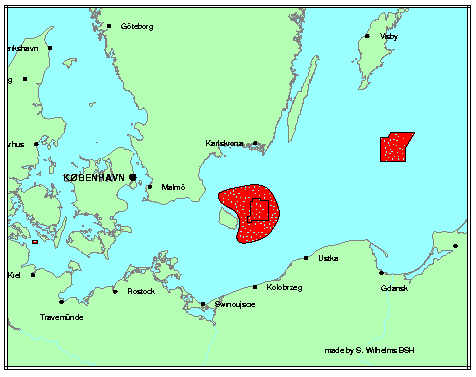Press release
Catches of chemical munitions in the Baltic remain low
Helsinki, 11 October (HELCOM) - For the second year in a row, Baltic fishermen have reported a record low number of incidents of dumped WWII chemical munitions being caught in their nets. According to the latest annual statistics, recently submitted by Denmark to HELCOM, there were only four small-scale catches in 2005, the same number as in 2004, compared to 25 incidents reported in 2003.
This is the lowest figure for annual catches since 1999. However, experts are not yet attributing the decrease to any specific factors. The reason for the dramatic decrease is unknown, as was the case for the dramatic increase in 2003. The variations are probably due to a combination of different factors, such as the intensity of fishing activities in the areas close to the dumped chemical munitions, and the recommendations issued by HELCOM and local authorities.
As Lead Country for monitoring dumped chemical munitions, Denmark prepared the latest annual report based on information received as of 31 August 2006. All the catches occurred east of Bornholm, near an area where large amounts of chemical munitions were dumped after World War II. Most of the netted chemical munitions caught in 2005 were completely corroded, and all four consisted of lumps of mustard gas, with a total weight of approximately 105 kg. All catches were released at sea. The total weight of the chemical munitions caught in 2005 was slightly lower than in 2004 – when three separate incidents involved mustard gas, with a total weight of approximately 140 kg netted in clay-like lumps, and another episode involved a 20 kg lump of sneeze gas caught by a fishing vessel. Most of the catches were released by fishermen at sea, although one catch was brought ashore for safe disposal.
The year 2003, when a total of 1 110 kg of gas-derived lumps was netted in 25 incidents represented one of the biggest increases in both the numbers of incidents and the total weight of the chemical munitions caught in the Baltic Sea since the mid-1990s. Over the period 1995-2002, about 3 -11 incidents were reported annually, with the total weight of munitions involved not exceeding 512 kg a year. The highest number of incidents during the last 20 years was in 1991 when a total of 5 378 kg of munitions was netted in 103 incidents.
About 40 000 tonnes of chemical munitions were dumped into the Baltic Sea after the Second World War – mostly in the area to the east of Bornholm, southeast of Gotland and south of the Little Belt. It is estimated that these chemical munitions contained some 13 000 tonnes of chemical warfare agents. Dumping areas are marked as foul, with “anchoring and fishing not recommended” on nautical charts. However, fishing in these waters is not prohibited, and commercial fishing is continuing.
Warfare agents are also discovered outside the dumping areas from time to time, especially near Bornholm. Fishermen in these waters regularly find bombs, shells or fragments of munitions and even lumps of mustard gas in their bottom trawl nets. The crews of fishing vessels risk contamination from chemical warfare agents if lumps of viscous mustard gas or chemical munitions caught in bottom trawls are hauled on board. Simply touching these chemical agents or inhaling their vapours is very dangerous.
Chemical warfare agents break down at varying rates into less toxic, water-soluble substances. Some compounds, however, show an extremely low solubility and slow degradability (e.g. viscous mustard gas, Clark I and II, and Adamsite). These compounds cannot occur at higher concentrations in water, so any wide-scale threat to the marine environment from these dissolved chemical warfare agents can be ruled out. HELCOM has carried out extensive assessments and concluded that any threat to coastal areas from such residues of warfare agents or chemical munitions is also unlikely.

Note to Editors:
The Helsinki Commission, or HELCOM, works to protect the marine environment of the Baltic Sea from all sources of pollution through intergovernmental co-operation between the countries bordering the sea - Denmark, Estonia, Finland, Germany, Latvia, Lithuania, Poland, Russia, Sweden, and also the European Community.
HELCOM is the governing body of the "Convention on the Protection of the Marine Environment of the Baltic Sea Area," more usually known as the Helsinki Convention.
For more information, please contact:
Mr. Nikolay Vlasov
Information Secretary
HELCOM
Tel: +358 (0)207 412 635
Fax: +358 (0)207 412 639
E-mail: nikolay.vlasov@helcom.fi

